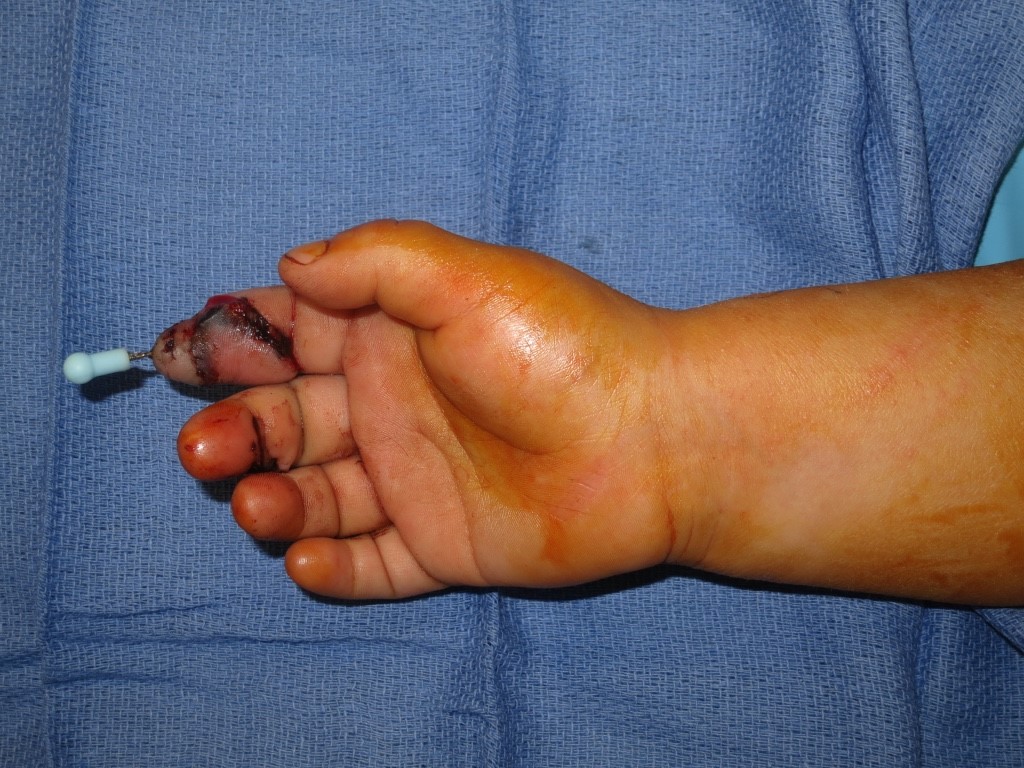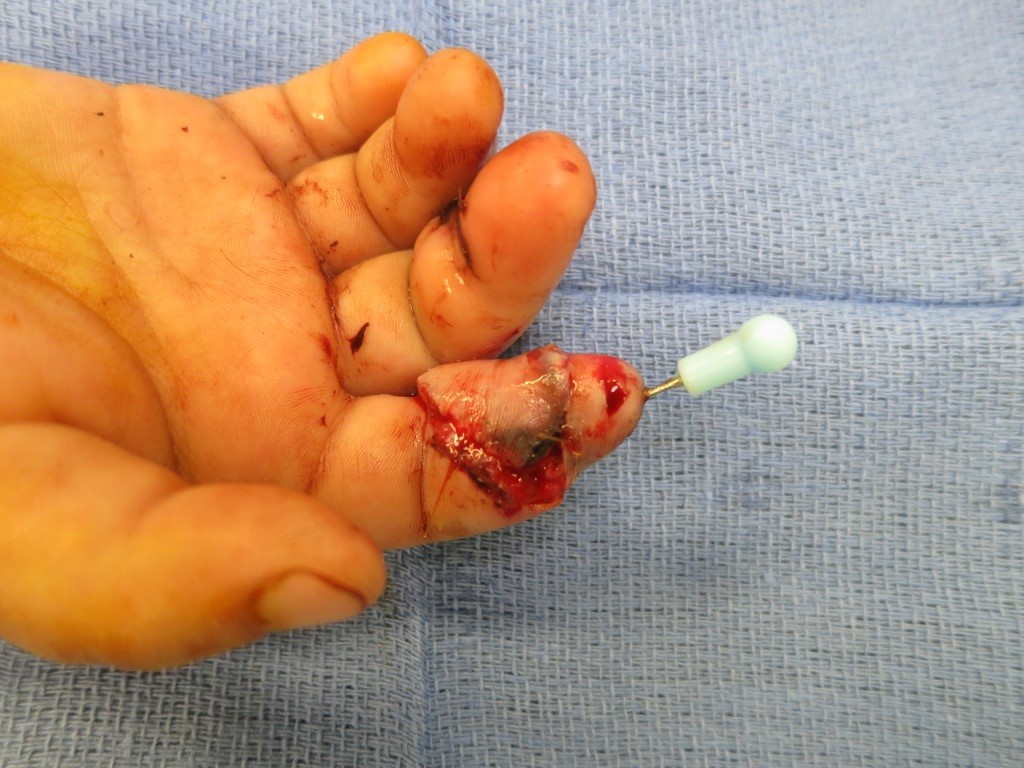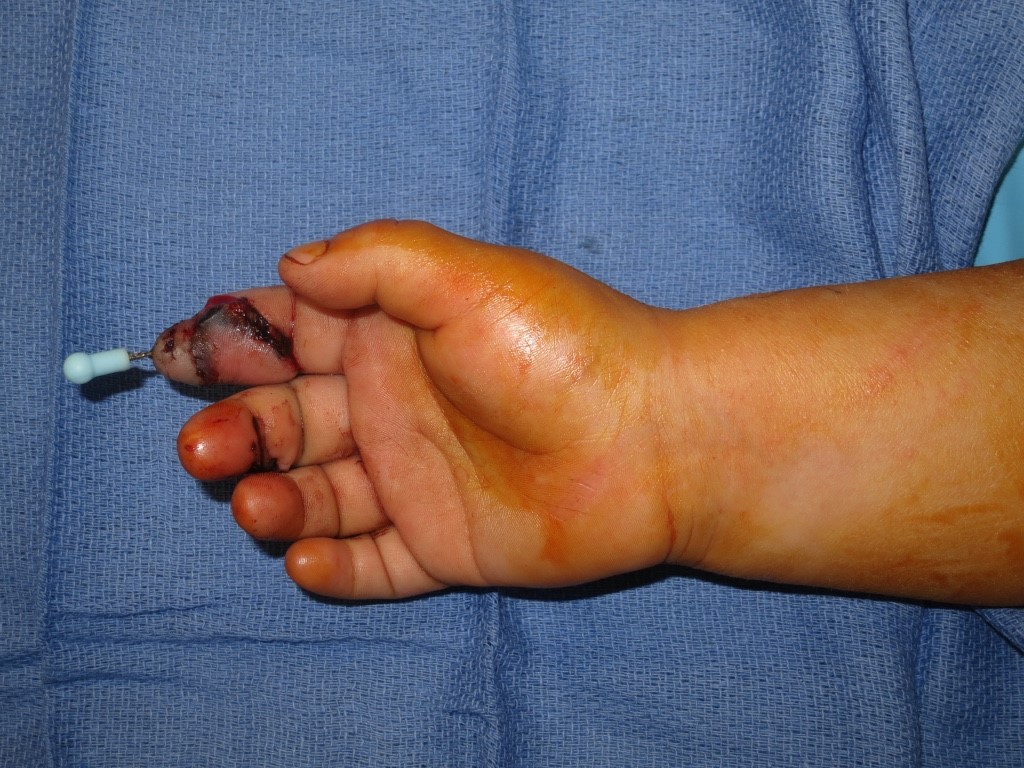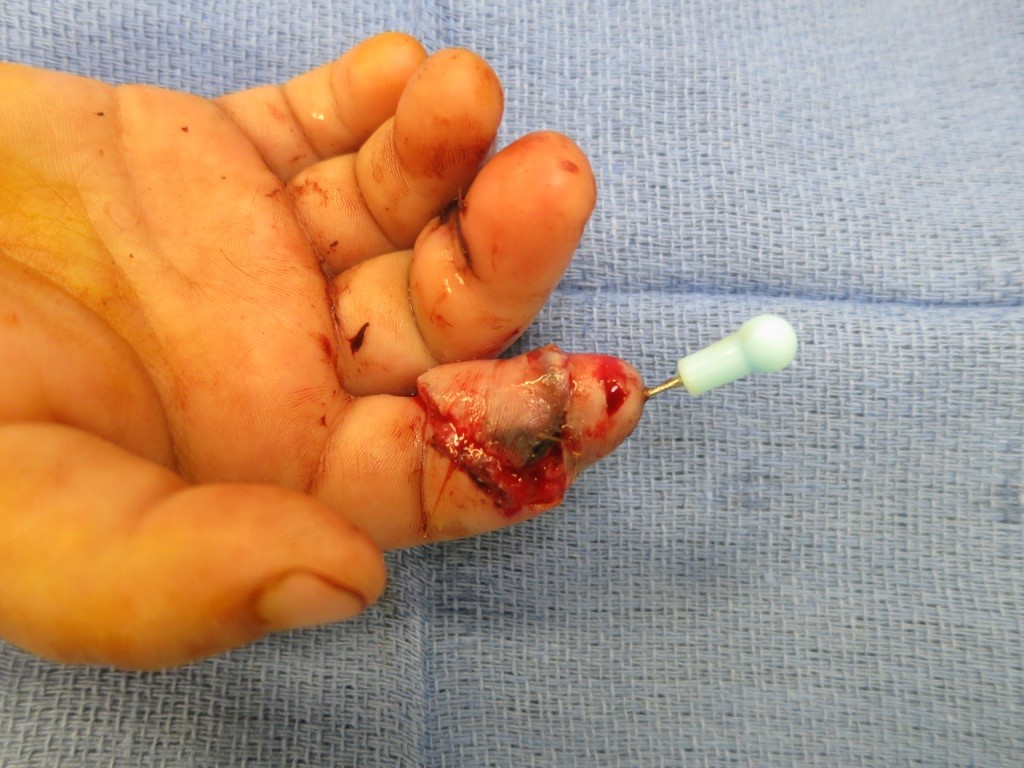Although a recognized phenomenon in cardiology, the implications of rebound heparin hypercoagulability following cessation of therapy in microsurgery is unreported. In this article we report two cases of late digital circulatory compromise following replantation, shortly after withdrawal of heparin. We propose potential consideration for changes in perioperative anticoagulation practice to reduce this risk. In conclusion, if heparin is instituted as the treatment of choice following microvascular repair, continuation of heparin therapy until neovascularization has occurred may reduce the risk of the rebound hypercoagulation. Addition of aspirin or other antiplatelet agents as used in the acute coronary setting may also have a role at minimizing the effect.
Rebound hypercoagulation following cessation of heparin therapy has previously been reported in the cardiology setting [1-3]. Initially it was recognized following reinfarction clustering within hours of discontinuation of unfractionated heparin infusion (UFI) during treatment of ST elevation myocardial infarction [4]. Reactivation of the coagulation system and elevated thrombin production following heparin withdrawal was proposed as the likely cause [3]. With loss of therapeutic heparin levels, prothrombotic factors interact with the original thrombus rapidly resulting in propagation, platelet recruitment and new ischaemia [5]. In vivo studies have further explained the molecular pathogenesis [2]. Increases in plasma prothrombin fragment 1+2 (F1+2) and thrombin-antithrombin (TAT) levels were recorded on heparin withdrawal that were beyond those measured prior to commencing heparin therapy [1].
Although a recognized phenomenon in cardiology, the implications of rebound heparin hypercoagulability in microsurgery are as yet unreported. In both the elective and trauma microsurgical setting, heparin is a component of the postoperative protocol for many European and American micro-surgeons, despite limited evidence for its efficacy [6,7]. Propagation of thrombosis in a microvascular anastomosis is similar to the pathological progression of thrombosis propagation in coronary arteries, and can result in critical tissue loss.
In this article we report two cases of late digit circulatory compromise shortly after withdrawal of heparin therapy. Additionally, we propose potential consideration for changes in perioperative anticoagulation practice to reduce this risk.
Case 1
A three-year-old right hand dominant healthy male who sustained near-complete amputation of his right index finger through the distal interphalangeal joint when both hands were caught in the hinge of metal portable truck ramp. Vaccines including tetanus were up to date and he had no current medical issues.
The patient was taken emergently to the operating theatre within 4 hours of injury, for revascularization of the digit. Open reduction and percutaneous pinning with volar plate, collateral ligament, flexor digitorum profundus repair and extensor dermodesis was carried out. The ulnar digital artery (UDA), nerve (UDN) and a vein were repaired primarily under the microscope without requirement of a vein graft. The patient tolerated the procedure well, with no flow issues on the operating table and was transferred to the Pediatric Intensive Care Unit (PICU) for standard flap / replant monitoring.

Figure 1. New onset fingertip ischemia following heparin withdrawal in Case 1.
A heparin (500 units) infusion and 60.75mg of daily aspirin were commenced postoperatively. The room was kept warm, and a forced air warming blanket kept on the right hand at all times. On postoperative day three, the heparin infusion was discontinued. He remained in the PICU with ongoing neurovascular checks. No other surgical or medical interventions that may have impacted upon circulation were performed in this time period (i.e., removal of warming blanket or change in other systemic factors). Approximately 21 hours later, the finger was noted to be cool and pale (Figure 1). No doppler signal was found. The patient returned to theatre emergently for exploration and an arterial thrombus at the anastomosis was noted. Flow was re-established, he was returned to the PICU postoperatively for ongoing neurovascular checks and recommenced on the heparin infusion (Figure 2).

Figure 2. Image of fingertip following salvage in Case 1.
This continued for a further five days post return to theatre at which stage he was transitioned to therapeutic enoxaparin for the remainder of his inpatient stay, for a total of seven days of postoperative anticoagulation. He was discharged on a further 30-day course of aspirin. At first outpatient follow-up the replanted digit was found to be viable with no further episodes of vascular compromise noted.
Case 2
A twenty-seven-year-old right hand dominant male presented with right thumb amputation by miter saw, through the proximal phalanx with six-hour cold ischemia time. No significant past medical history. Social history included smoker of one pack / day and current occupation as a carpenter.
He was taken to the operating room for emergent replantation, which included debridement, shortening and K-wire bony fixation. The flexor pollicis longus (FPL) and extensor pollicis longus (EPL) tendon were repaired. The radial digital artery (RDA) underwent microsurgical repair in addition to two veins and the UDN. Flow was restored without any intraoperative issue. The patient was bolused with 3000 units of heparin IV and placed on a 500-unit heparin infusion. A therapeutic 300mg aspirin suppository was given on transfer to the post-anesthesia care unit, then 81mg aspirin was commenced daily. Recovery was uneventful until day three post operatively when the heparin infusion turned off. Again, no other interventions in this time period that may have impacted upon circulation were carried out. Within two hours of ending the infusion the thumb became clinically congested requiring reinstitution of intravenous heparin, and therapeutic leaching. Inflow was maintained and the patient improved with the above measures therefore operative intervention was not required. The patient was subsequently discharged on daily aspirin and therapeutic enoxaparin for two weeks. At first outpatient follow-up the thumb was viable with no further episodes of vascular compromise.
The consequence of intravascular thrombosis was first described in the mid- 1800s by the German physician Rudolf Virchow [8]. It is only over the past three decades, however, that advances in immunohistochemistry and flow cytology have allowed molecular mapping of the processes underlying Virchow’s original triad of hypercoagulability, vessel damage and blood flow stasis [9]. The cases we present of late thrombosis following the cessation of heparin infusion to make hand surgeons aware of this possible preventable sequela.
Those undergoing microsurgical reconstruction or digital revascularization have their thrombotic risk compounded by a range of injury and patient specific factors. Transection and trauma to the vessel wall leading to exposure of subendothelial structures to blood flow [10], which has been shown to have the greatest single impact on acute anastomotic thrombosis [11]. This acute insult is followed by postoperative inflammatory response, upregulation of endothelial P-selectin surface expression and relative vessel wall hypoxia during neo-endothelialization [12], which can take a further two - six days in animal models to occur [13]. Localization of the tissue injury (e.g., extremities, high energy trauma or concurrent contamination or infection) further increase this risk [14].
Additional patient specific risks, namely dehydration and long periods of immobility, also exacerbate the likelihood of postoperative thrombosis [15]. In this setting a further pro-thrombotic insult, i.e., the acute withdrawal of heparin and subsequent thrombotic rebound, could be enough to produce microvascular thrombosis, as in the cases discussed. Interestingly this is in fact opposite to the more commonly recognized HITT (Heparin Induced Thrombocytopenia Thrombosis) phenomenon more commonly described in the hospitalized population. HITT occurs on initiation of heparin therapy rather than cessation.
Although no specific guidance exists in the microvascular setting to reduce the risk of rebound heparin thrombosis at this present time, a significant amount of cardiology guidelines have been produced addressing this event in acute coronary syndrome following heparin withdrawal. Aspirin has been shown to blunt the effects of rebound thrombosis after heparin withdrawal improving survival in cardiac patients [16]. The patients presented remained on aspirin during heparin withdrawal however, possibly highlighting the different pathogenesis in the microsurgical clinical scenario. This complicates drawing any direct conclusion over use of one or both drugs in this different clinical setting. If heparin is instituted however, we would recommend the continuation of therapy until vessel neovascularization has occurred (for a period of at least 6 days or longer based on animal studies [13]). Given the additional risk of side effects, i.e., bleeding or gastric ulceration, the decision to institute additional medications in the microvascular setting should be judicious and patient specific.
Rebound hypercoagulation following withdrawal of heparin therapy is a rare but recognized treatment sequelae. Given the period of inflammation that immediately follows microvascular repair in both the elective and trauma setting we would suggest maximizing patient factors through hydration and early mobility (i.e., walking, not digit/extremity mobility) as the primary treatment modality.
The use of heparin therapy in the post-operative period after revascularization or replantation remains controversial based on current evidence [17,18]. To date there is no high-level evidence supporting use of any medications in microsurgery as a means to reduce risk of arterial or venous thrombosis. Higher level studies are urgently needed to investigate the clinical efficacy of antithrombotic medications in microsurgery; however, given the small failure rates in modern practice, these will need to be large multicenter trials in order to reach sufficient power [6].
If heparin is instituted in the perioperative setting, the continuation of heparin therapy until neovascularization has occurred (for a period of at least 6 days or longer [13]) may reduce the risk of the rebound hypercoagulation. Addition of aspirin or other antiplatelet agents as used in the acute coronary setting may have a role at minimizing this effect [19]. However, as in the first case presented, Aspirin alone was not effective in preventing circulatory compromise. As no current international guidelines exist, use of any anticoagulation therapy should be carefully considered. Additionally, a full explanation of the potential side effects of anticoagulation prior to institution should be given to patients.
If heparin is instituted as the treatment of choice following microvascular repair, continuation of heparin therapy until neovascularization has occurred may reduce the risk of the rebound hypercoagulation. Addition of aspirin or other antiplatelet agents as used in the acute coronary setting may also have a role at minimizing the effect.
Received date: November 12, 2020
Accepted date: May 10, 2021
Published date: June 25, 2021
The study is in accordance with the ethical standards of the 1964 Helsinki declaration and its later amendments or comparable ethical standards. The University of Washington does not require ethical approval for reporting individual cases or case series. Written informed consent was obtained from the patient(s) for their anonymized information to be published in this article.
The study did not receive any specific grant from funding agencies in the public, commercial, or not-for-profit sectors.
The authors report no financial or other conflict of interest relevant to this article, which is the intellectual property of the authors.
© 2021 The Authors. This is an open-access article distributed under the terms of the Creative Commons Attribution 4.0 International License (CC-BY).


The communication among international microsurgeons have switched from one direction (from paper, textbook) to multiway interactions through the internet. The authors believe the online platform will play an immensely important role in the learning and development in the field of microsurgery.
Traditionally, suturing techniques have been the mainstay for microvascular anastomoses, but owing to its technical difficulty and labour intensity, considerable work has gone into the development of sutureless microvascular anastomoses. In this review, the authors take a brief look at the developments of this technology through the years, with a focus on the more recent developments of laser-assisted vascular anastomoses, the unilink system, vascular closure staples, tissue adhesives, and magnets. Their working principles, with what has been found concerning their advantages and disadvantages are discussed.
Prof. Koushima, president of World Society for Reconstructive Microsurgery, proposes an innovative concept and technique of the multi-stage ‘Orochi’ combined flaps (sequential flaps in parallel). The technique opens a new vista in reconstructive microsurgery.
The video presents a useful technique for microvascular anastomosis in reconstructive surgery of the head and neck. It is advantageous to use this series of sutures when working with limited space, weak vessels (vessels irradiated, or with atheroclastic plaques), suturing in tension, or suturing smaller vessels (less than 0.8 cm in diameter).
Authors discuss a silicone tube that provides structural support to vessels throughout the entire precarious suturing process. This modification of the conventional microvascular anastomosis technique may facilitate initial skill acquisition using the rat model.
PEDs can be used as alternative means of magnification in microsurgery training considering that they are superior to surgical loupes in magnification, FOV and WD ranges, allowing greater operational versatility in microsurgical maneuvers, its behavior being closer to that of surgical microscopes in some optical characteristics. These devices have a lower cost than microscopes and some brands of surgical loupes, greater accessibility in the market and innovation plasticity through technological and physical applications and accessories with respect to classical magnification devices. Although PEDs own advanced technological features such as high-quality cameras and electronic loupes applications to improve the visualizations, it is important to continue the development of better technological applications and accessories for microsurgical practice, and additionally, it is important to produce evidence of its application at surgery room.
Avulsion injuries and replantation of the upper arm are particularly challenging in the field of traumatic microsurgery. At present, the functional recovery of the avulsion injuries upper arm after the replantation is generally not ideal enough, and there is no guideline for the surgeries. The aim of this study was to analyze the causes of failure of the upper arm replantation for avulsion injuries, summarize the upper arm replantation’s indications, and improve the replantation methods.
The supraclavicular flap has gained popularity in recent years as a reliable and easily harvested flap with occasional anatomical variations in the course of the pedicle. The study shows how the determination of the dominant pedicle may be aided with indocyanine green angiography. Additionally, the authors demonstrate how they convert a supraclavicular flap to a free flap if the dominant pedicle is unfavorable to a pedicled flap design.
In a cost-effective and portable way, a novel method was developed to assist trainees in spinal surgery to gain and develop microsurgery skills, which will increase self-confidence. Residents at a spine surgery center were assessed before and after training on the effectiveness of a simulation training model. The participants who used the training model completed the exercise in less than 22 minutes, but none could do it in less than 30 minutes previously. The research team created a comprehensive model to train junior surgeons advanced spine microsurgery skills. The article contains valuable information for readers.
The loupe plays a critical role in the microsurgeon's arsenal, helping to provide intricate details. In the absence of adequate subcutaneous fat, the prismatic lens of the spectacle model may exert enormous pressure on the delicate skin of the nasal bone. By developing a soft nasal support, the author has incorporated the principle of offloading into an elegant, simple yet brilliant innovation. A simple procedure such as this could prove invaluable for microsurgeons who suffer from nasal discoloration or pain as a result of prolonged use of prismatic loupes. With this technique, 42% of the pressure applied to the nose is reduced.
An examination of plastic surgery residents' experiences with microsurgery in Latin American countries was conducted in a cross-sectional study with 129 microsurgeons. The project also identifies ways to increase the number of trained microsurgeons in the region. The authors claim that there are few resident plastic surgeons in Latin America who are capable of attaining the level of experience necessary to function as independent microsurgeons. It is believed that international microsurgical fellowships would be an effective strategy for improving the situation.
This retrospective study on the keystone design perforator island flap (KDPIF) reconstruction offers valuable insights and compelling reasons for readers to engage with the article. By sharing clinical experience and reporting outcomes, the study provides evidence of the efficacy and safety profile of KDPIF as a reconstructive technique for soft tissue defects. The findings highlight the versatility, simplicity, and favorable outcomes associated with KDPIF, making it an essential read for plastic surgeons and researchers in the field. Surgeons worldwide have shown substantial interest in KDPIF, and this study contributes to the expanding knowledge base, reinforcing its clinical significance. Moreover, the study's comprehensive analysis of various parameters, including flap survival rate, complications, donor site morbidity, and scar assessment, enhances the understanding of the procedure's outcomes and potential benefits. The insights garnered from this research not only validate the widespread adoption of KDPIF but also provide valuable guidance for optimizing soft tissue reconstruction in diverse clinical scenarios. For readers seeking to explore innovative reconstructive techniques and improve patient outcomes, this article offers valuable knowledge and practical insights.
This comprehensive review article presents a profound exploration of critical facets within the realm of microsurgery, challenging existing paradigms. Through meticulous examination, the authors illuminate the intricate world of microangiosomes, dissection planes, and the clinical relevance of anatomical structures. Central to this discourse is an exhaustive comparative analysis of dermal plexus flaps, meticulously dissecting the viability and potential grafting applications of subdermal versus deep-dermal plexi. Augmenting this intellectual voyage are detailed illustrations, guiding readers through the intricate microanatomy underlying skin and adjacent tissues. This synthesis of knowledge not only redefines existing microsurgical principles but also opens new frontiers. By unearthing novel perspectives on microangiosomes and dissection planes and by offering a comparative insight into dermal plexus flaps, this work reshapes the landscape of microsurgery. These elucidations, coupled with visual aids, equip practitioners with invaluable insights for practical integration, promising to propel the field of microsurgery to unprecedented heights.
This article presents a groundbreaking surgical approach for treating facial paralysis, focusing on the combination of the pronator quadratus muscle (PQM) and the radial forearm flap (RFF). It addresses the challenges in restoring facial functions and skin closure in paralysis cases. The study's novelty lies in its detailed examination of the PQM's vascular anatomy when combined with the RFF, a topic previously unexplored. Through meticulous dissections, it provides crucial anatomical insights essential for enhancing facial reanimation surgeries, offering significant benefits in medical practices related to facial reconstruction and nerve transfer techniques.
This article exemplifies a significant advancement in microsurgical techniques, highlighting the integration of robotic-assisted surgery into the deep inferior epigastric perforator (DIEP) flap procedure for breast reconstruction. It demonstrates how innovative robotic technology refines traditional methods, reducing the invasiveness of surgeries and potentially lessening postoperative complications like pain and herniation by minimizing the length of the fascial incision. This manuscript is pivotal for professionals in the medical field, especially those specializing in plastic surgery, as it provides a comprehensive overview of the operative techniques, benefits, and critical insights into successful implementation. Moreover, it underscores the importance of ongoing research and adaptation in surgical practices to enhance patient outcomes. The article serves as a must-read, not only for its immediate clinical implications but also for its role in setting the stage for future innovations in robotic-assisted microsurgery.
The groundbreaking study illuminates the complex mechanisms of nerve regeneration within fasciocutaneous flaps through meticulous neurohistological evaluation, setting a new benchmark in experimental microsurgery. It challenges existing paradigms by demonstrating the transformative potential of sensory neurorrhaphy in animal models, suggesting possible clinical applications. The data reveal a dynamic interplay of nerve recovery and degeneration, offering critical insights that could revolutionize trauma management and reconstructive techniques. By bridging experimental findings with hypothetical clinical scenarios, this article inspires continued innovation and research, aimed at enhancing the efficacy of flap surgeries in restoring function and sensation, thus profoundly impacting future therapeutic strategies.
This article presents the first comprehensive review of refractory chylous ascites associated with systemic lupus erythematosus, analyzing 19 cases to propose an evidence-based therapeutic framework. It introduces lymphatic bypass surgery as an effective option for this rare complication, overcoming the limitations of conventional treatment. By integrating mechanical drainage, immunomodulation, and lymphangiogenesis, this approach achieves rapid and sustained resolution of ascites. The findings offer a novel surgical strategy for autoimmune lymphatic disorders and prompt a re-evaluation of their complex pathophysiology. This study demonstrates how surgical innovation can succeed where traditional therapies fail, offering new hope in managing refractory autoimmune disease.
This case highlights the use of a bipedicled deep inferior epigastric perforator (DIEP) flap for reconstructing a massive 45 × 17 cm chest wall defect following bilateral mastectomy. By preserving abdominal musculature and utilizing preoperative computed tomographic angiography (CTA) for perforator mapping, the technique enabled tension-free bilateral microvascular anastomosis to the internal mammary arteries. The incorporation of submuscular mesh and minimal donor-site undermining maintained abdominal wall integrity. At six-month follow-up, no hernia or functional deficits were observed, and the patient reported high satisfaction on the BREAST-Q. This muscle-sparing strategy offers a viable alternative for large, midline-crossing chest wall defects where conventional flaps may be insufficient.
Motorcycle chain-induced fingertip amputations represent a reconstructive dead end, where severe crushing and contamination traditionally compel revision amputation. The authors dismantle this exclusion criterion, reporting an 83% salvage rate using a modified protocol of radical debridement, strategic skeletal shortening, and simplified single-vessel supermicrosurgery. By eschewing complex grafting for tension-free primary anastomosis, the authors successfully restored perfusion in ostensibly
This article presents a case study on the successful replantation of a pediatric lower lip after a dog bite, focusing on artery-only microanastomosis. It highlights the challenges and effective strategies in pediatric microvascular surgery, particularly emphasizing the importance of specialized surgical techniques and thorough postoperative care. Alongside the case study, an extensive literature review supports the feasibility of artery-only anastomosis and the traditional yet critical use of leech therapy for managing venous congestion. This research is vital for medical professionals specializing in pediatric surgery, offering key insights into improving both functional and aesthetic outcomes for young patients. Additionally, it identifies gaps in long-term research and stresses the need for ongoing studies to refine treatment protocols, making it an indispensable resource for enhancing patient care and outcomes in pediatric reconstructive surgeries.
McGarry K, Larsen M, Pet MA, Moore AM. Digital vessel thrombosis after early cessation of heparin therapy following reimplantation: Two case reports. Int Microsurg J 2021;5(1):3. https://doi.org/10.24983/scitemed.imj.2021.00141